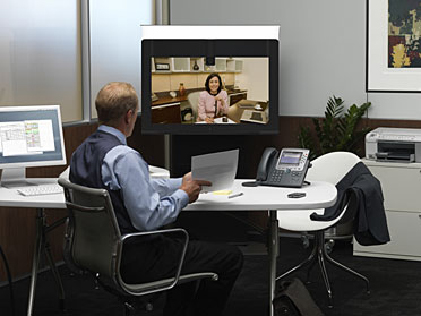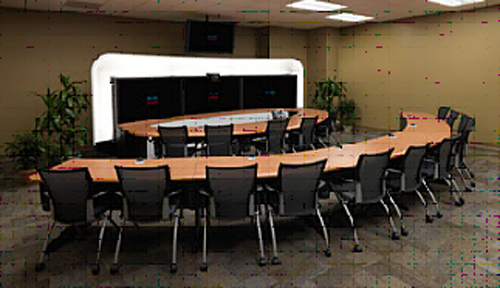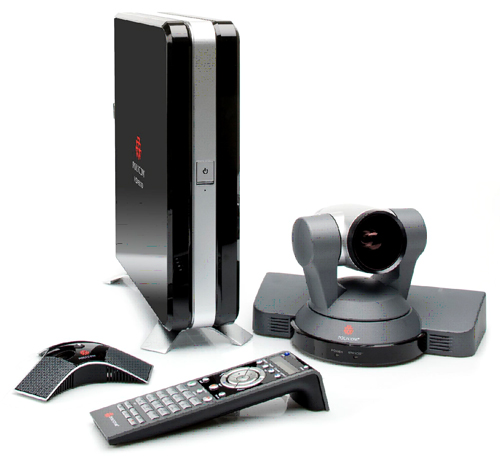Analysts and industry insiders agree that in today’s global and distributed business environment, video conferencing provides a viable alternative to travel and an effective means of facilitating communication among colleagues and customers. The current terminology used to describe the video conferencing market, however, is not as clear. The traditional category of video conferencing has widened to include newer technologies such as telepresence which enables a life-like meeting experience - participants feel they are actually sitting at the same table and communicating face-to-face (HP’s Halo Collaboration Meeting Room is pictured).

Top vendors in the video conferencing space note that “visual communications” is an apt description of this market since this naming encompasses a spectrum of video possibilities, including telepresence solutions, room-based video systems, desktop systems and video phones. Nevertheless, some analysts still call this market video conferencing, while others use the broader categories of “collaboration” or “IP communications,” or include it as a subset of “unified communications.”
Perhaps “Video Conferencing and Telepresence (News - Alert)” is the safest bet for now since it describes the technology, and also incorporates the latest trend – telepresence. A number of vendors competing in this rapidly growing market, including top players Cisco, Polycom (News - Alert) and Tandberg, recognize that businesses have different video conferencing needs, depending on budget, space requirements and required applications. To this end, they continue to develop comprehensive portfolios that include next generation, immersive telepresence solutions (single or multi-screen) for a life-like (and life-size) audio and visual experience, as well as single- or multi-screen group- or room-based video conferencing, executive desktop systems and cost-effective PC-based solutions that target workers on-the-go. And, video VoIP phones can also deliver desktop video, along with voice communications, at an affordable price. A number of other vendors compete in specific segments of this market, including HP, LifeSize, Sony, Teliris and others.
In addition to the collaborative advantages, vendors of these solutions are highlighting the cost-cutting aspect and benefits to the environment, emphasizing that video and telepresence, as an alternative to travel, are helping companies to significantly lower the costs and carbon emissions associated with travel. Some governments in Europe and Asia are now mandating environmental policies, and many companies in the United States have begun their own initiatives, actively using video conferencing to reduce travel costs and help our planet. Some are instituting company travel policies that require virtual meetings instead of travel.
Businesses considering the deployment of video conferencing or telepresence can take advantage of professional services programs such as Going Green for Polycom, a three-step methodology designed to help an organization plan and implement video conferencing per their specific objectives. In addition to a video readiness assessment and rollout, the program also measures the actual “savings” that result from reduced travel, both in terms of cost and in environmental benefits. A software application called Video-Miles (from The Visual Environment, a Polycom ARENA partner) calculates the mileage savings and carbon savings to come up with the Return on Investment (ROI) which results from using a video conference. Polycom customers report increases in travel cost savings of over 30 percent and carbon savings which are growing at 25 percent per quarter.
Below are some new solutions in the video conferencing and telepresence market. Top vendors, Cisco, Polycom and Tandberg have all recently unveiled new video conferencing solutions that broaden their portfolios, but also incorporate the latest technological developments, including high definition resolution and wideband audio.
Cisco Broadens TelePresence Portfolio with Personal and Large Group Endpoints
Earlier in 2008, Cisco Systems (News - Alert) announced two new endpoints for Cisco TelePresence, a meeting solution that combines video, audio and remote communication technologies over an IP network for a “face-to-face” experience. The new environments include a personal system (TelePresence System 500) and a large group system (TelePresence System 3200) which expand the Cisco TelePresence portfolio that was first introduced in 2006 (initial solutions included the TelePresence System 1000 for small group meetings and TelePresence System 3000 for staff meetings or customer/partner collaborations).
Cisco TelePresence incorporates high definition video (1080p) and wideband spatial audio - innovative technologies that allow meeting participants to be located anywhere in the world, but see and hear others at the meeting as if they are actually present. Cisco TelePresence was designed not only as a complete system, but also around human-factors engineering so that the experience is as virtual as possible, according to Cisco.
Cisco TelePresence 500 ($33,900) is a complete, private office solution that includes a 37-inch display, camera, a microphone array, speakers and specially designed lighting. Alternatively, Cisco TelePresence 500 can function as a second monitor or as a digital sign. The second new offering, TelePresence 3200 ($340,000), builds on the earlier 6-person TelePresence 3000 environment, adding a second row of seating with table configurations that seat larger teams (12 or 18 participants). A $90,000 upgrade kit is available for Cisco TelePresence 3000 customers to upgrade to the 3200 model.

The Cisco TelePresence Advanced Technology Provider (ATP (News - Alert)) Program is available to assist partners in delivering a high quality experience to customers.
Polycom Expands Telepresence Portfolio with TPX, Supports 1080p High Definition
In June 2008, Polycom announced three new Polycom Telepresence Experience (TPX) solutions designed to create a “same-room,” life-like experience that makes participants feel they are sitting at the same table, though they are actually in separate locations. These “immersive” TPX solutions facilitate telepresence meetings in small, medium and large conference room environments and accommodate two to six people in each location.
The new TPX 306M (pictured) is a three-screen solution for medium and large environments, supporting up to six people on camera per location. Components include three High Definition (HD) 60-inch plasma displays, three HD video cameras, a room control system with color touch panel, a Polycom SteroSurround Speaker Kit, two Polycom digital ceiling microphone arrays and three Polycom HDX video codecs. Three 15-inch color content displays are built into the table and can be raised and lowered to let meeting participants view presentations, video clips, images and other content during the meeting. For TPX solutions that don’t include the built-in table displays, Polycom offers an optional, free-standing 50-inch monitor to display content during a telepresence call.
Two additional TPX versions target smaller meeting environments. TPX 204M is a two-screen solution for small and medium environments (four people per location), and TPX 102M is a single screen solution for small meetings (two people per location). Polycom TPX 306M with built-in table displays starts at US$219,000, while TPX 204M is priced from US$125,000 and TPX 102M from US$75,000. All are available now through certified Polycom channel partners in North America, Europe and some Asian countries.
Just this fall Polycom made several announcements around its portfolio of video conferencing solutions, adding 1080p high definition (HD) resolution, a new conference room system and a next generation video network management solution. These new offerings build upon Polycom’s comprehensive portfolio of video conferencing systems that includes the so-called immersive Telepresence Experience (TPX) solutions (2-6 people on camera) and the RealPresence Experience (RPX) solutions for up to 28 people on camera in each location. Polycom also offers the Polycom HDX conference room portfolio (HDX 4000, 7000, 8000, 9000), including the HDX 4000 personal telepresence solution for executive desktops or for a small conference room (up to four people on camera). And, the RMX 2000 is a real-time, on-demand platform for ad-hoc multi-point video conferencing in conference rooms and on desktops and mobile devices.

Previously, all Polycom high definition telepresence solutions utilized 720p video resolution at 30 frames per second, but now Polycom announces support for 1080p high definition (HD) resolution (30 frames per second) across its entire telepresence product line, including RPX, TPX and HDX series telepresence products and the RMX 2000. In environments where 1080p is not possible for all sites or all participants involved in a particular video conference (all cameras, displays and peripherals must be capable of 1080p to achieve full value), Polycom also announces support for 720p at 60 frames per second which enables excellent resolution and the same frame rate as broadcast HDTV for motion handling, while utilizing less bandwidth. Support for these improved resolutions is planned for first quarter 2009.
New in the HDX line is the HDX 8006, a high definition room telepresence solution designed for medium and large conference rooms. The HDX 8006 system (pictured) is capable of supporting 1080p and 720p/60 HD and features a new 1080p EagleEye camera, a remote control and a 360-degree microphone array that is immune to interference from mobile devices, according to Polycom. The company also offers HDX 8006 Media Center configurations with single or dual monitors, a stand or wall mount option and an integrated audio system (US$17,499 for base package; $19,499 or $22,099 for XL Package or XLP Package).
Bringing the network together is the Converged Management Application (CMA) that provides centralized provisioning and video network management for an organization’s entire network of video and telepresence endpoints and infrastructure systems. A key component is the CMA Desktop, an integrated, scalable desktop video application for PCs that allows users to make video calls using a presence-based contact list tied to the corporate directory. CMA Desktop video clients interoperate with standards-based video endpoints, including the Polycom RPX, TPX and HDX telepresence systems and standards-based systems from other vendors. (CMA is a next generation replacement for Polycom’s earlier ReadiManager.)
Tandberg Previews HD PC Video Conferencing, Announces Telepresence T3
Tandberg previewed its Tandberg HD (high-definition) PC video conferencing technology in August 2008, a solution that targets mobile workers who need to communicate visually from anywhere. For teleworkers, commuters, remote workers and business travelers who are often on the road, video conferencing over a laptop enables simple visual communication and collaboration with a face-to-face experience, though participants are miles apart.
The company demonstrated business quality conference calls at 720p30 resolution (30 frames per second) using a Tandberg PrecisionHD camera and a high performance Intel Mobile Core 2 Quad laptop running Tandberg’s Movi software, Generation Two due out first quarter 2009. Intel chose to demonstrate that its quad system (4-processor CPU) not only handles high-definition video conferencing on a laptop, but also can simultaneously run other critical business applications. Tandberg notes that Movi software is standards-based and can run on any Windows PC, so it is not tied to the specific Intel platform used at the recent Intel Developer Forum.
Tandberg explains that its Movi software has been on the market for one year; however, the forthcoming second generation software will introduce a client/server architecture that enables the software to be installed on a server and available to thousands of clients. Unlike single installations such as those from Skype (News - Alert) or Yahoo, enterprises that require scalability and centralized management will find what they need in Tandberg's solution. This high quality PC video deployment scales to thousands of clients and provides superior quality (high resolution video up to 720p30), security (firewall traversal, AES and TLS encryption), ease of use (one–click connectivity with presence information) and manageability (Tandberg Management Suite).
The company is a market share leader in both endpoints and infrastructure with offices in 34 countries and sales, support and services in 90+ countries. The company offers a range of video conferencing solutions, including Telepresence solutions (three-screen, life-like audio and visual high definition conferencing), room-based video conferencing (single plasma screen or desktop screen solutions) and the PC-based Movi solution that targets mobile workers. A fourth solution, the E20 video VoIP phone (pictured), will function as a standard office phone, but will also deliver desktop video at an affordable price. E20 is planned for first quarter 2009 and represents a new market for Tandberg.
Tandberg will also begin shipping its new Telepresence T3 solution in January 2009 that delivers an 'across the table' meeting experience (per expert and customer feedback on designs, colors and room set-ups), but which also supports open standards so that it interoperates with other standards-based PC, desktop and room video systems (including HD systems). This native interoperability means that participants are not forced into a specific system, network or bandwidth. Notable characteristics include full HD (1080p) telepresence engines, large full HD screens and PrecisionHD 1080p cameras, integrated touch collaboration screens and full-duplex spatial audio with wideband stereo sound.
Customers can take advantage of Tandberg Total Service, a managed services offering that removes the burden of managing and operating a telepresence system and environment. Managed services providers handle the various stages of deployment and operation by performing local site surveys, network assessment and provisioning, telepresence room design and installation, and offering fully managed or hosted service options, on-site maintenance and support for remote devices.
Visit TelecomTactics to learn more about the business telephony market, including IP PBX systems, IP telephones and associated VoIP applications or sign up for a free issue of the TelecomTactics Insider e-newsletter. T3i Group will introduce Collaboration Tactics, a new database publication that covers services (Audioconferencing, Videoconferencing and Webconferencing services) and systems (Desktop/Personal, Room/Group and Video/Telepresence systems) from leading vendors. Stay tuned for more on this new program due out in January 2009.
Sandra M. Gustavsen, senior analyst for T3i Group, contributes her TelecomTactics column to TMCnet. To read more of Sandra’s articles, please visit her columnist page.
Edited by Michelle Robart
 Internet Telephony Magazine
Click here to read latest issue
Internet Telephony Magazine
Click here to read latest issue CUSTOMER
CUSTOMER  Cloud Computing Magazine
Click here to read latest issue
Cloud Computing Magazine
Click here to read latest issue IoT EVOLUTION MAGAZINE
IoT EVOLUTION MAGAZINE




